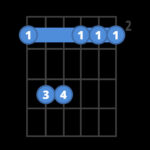The guitar capo is a seemingly simple device, yet it’s an incredibly versatile tool in any guitarist’s arsenal. Often underestimated, this clamp, known formally as capotasto (Italian for “head of fretboard”), is far more than just a shortcut. Its primary function is to raise the pitch of your guitar strings uniformly at a chosen fret. By effectively shortening the vibrating length of the strings, the Capo Of Guitar opens up a world of musical possibilities, allowing you to play songs in different keys without relearning chord shapes and explore new sonic territories on your instrument.
Unveiling the Versatility: Why Guitarists Use a Capo
Beyond simply changing keys, the benefits of using a guitar capo are numerous. For songwriters and arrangers, a capo is invaluable. Imagine you’ve written a song in the key of B, but your vocalist finds it more comfortable in C#. Instead of completely reworking chord voicings, a capo placed at the second fret instantly transposes the song, maintaining the original fingerings you’re accustomed to.
Furthermore, the guitar capo is a fantastic tool for exploring the guitar fretboard. By placing the capo at different frets, you can play familiar songs in new positions. For example, a song in E major can be played using A chord shapes with a capo at the 7th fret. This exercise not only helps you visualize the neck better but also leads to discovering unique voicings and fingerings you might not have otherwise considered. It’s a fantastic method for expanding your fretboard knowledge and creativity.
While some might consider using a capo as avoiding barre chords or transposing “the proper way,” seasoned players understand it’s simply another tool to enhance musical expression. Many legendary guitarists, from Pete Townshend and Keith Richards to folk icons like Bob Dylan and blues masters, have utilized the capo of guitar to create iconic sounds. George Harrison’s classic “Here Comes the Sun,” for instance, owes part of its bright and uplifting sound to the use of a capo.
Navigating the Types of Guitar Capos: Finding Your Perfect Fit
When choosing a guitar capo, the type of your guitar’s fretboard is a key consideration. Fretboards can be broadly categorized as flat or curved (radiused). Classical guitars with nylon strings and some steel-string acoustic guitars typically have flat fretboards, while most steel-string acoustics and electric guitars feature curved fretboards.
The market offers a variety of capo designs to suit different needs and preferences:
- Elastic Strap Capos: These are among the simplest and most affordable types. They consist of a rubber-coated bar and an elastic strap that wraps around the guitar neck to secure it. While budget-friendly and compact, they usually require two hands to adjust.
- Spring Clamp Capos: Favored for their speed and ease of use, spring-loaded clamp capos like the Dunlop Trigger can be attached or repositioned with just one hand. This makes them ideal for players who need to change capo positions quickly during performances.
- Screw or Adjustable Tension Capos: These capos use a screw mechanism to adjust the clamping pressure. This allows for precise control over the tension, minimizing string buzz and ensuring even pressure across all strings.
- Specialty Capos: For more specialized techniques, there are capos like partial capos, such as the Kyser Short Cut 3-String capo or the Third Hand partial capo. These innovative designs allow you to capo only a selection of strings, opening up unique tunings and chord voicings without fully transposing the entire guitar. These are excellent for creating drone-like sounds or achieving open-tuning effects without retuning.
Selecting the Right Capo for Your Guitar
If you own multiple guitars, you might find that different capos work best for each. A 12-string guitar, for instance, will likely require a capo with greater clamping pressure than a nylon-string classical guitar. Similarly, banjos and mandolins often necessitate specialized capos designed for their specific neck profiles.
While electronic transposition effects, such as pedals like the Digitech Whammy or Morpheus Capo pedal, exist, they come at a higher price point and don’t offer the tactile exploration of the fretboard that a physical capo of guitar provides.
In conclusion, if you’re new to using a guitar capo, experimenting with one is highly recommended. This small, inexpensive accessory can unlock a surprising range of new sounds and creative avenues in your guitar playing, enriching your musical journey and expanding your understanding of the instrument.

